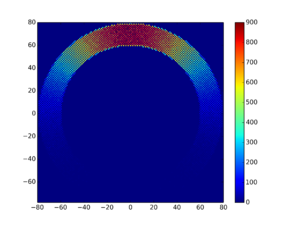Ploting 2D Density Colorful
From Computational Biophysics and Materials Science Group
I think you guys can use the code in this way:
python plot2d.py -i ~/data.txt -o result.png --ignore=',' --ignore='(' --ignore=')' \
--format='* * cor_x cor_y *' --vmax=300 --vmin=100
To dynamically read your data file. :-)
import sys, getopt #parameters
import matplotlib.pyplot as plt
from matplotlib.colors import Normalize#LogNorm
from pylab import *
def plot(input_file, vmax, vmin, ignore, line_format, output_png, silent):
xs = []
ys = []
index_x = line_format.split().index('cor_x')
index_y = line_format.split().index('cor_y')
with open(input_file) as f:
for line in f:
for _ignore in ignore:
line = line.replace(_ignore, ' ')
_line = line.split()
xs.append(_line[index_x])
ys.append(_line[index_y])
#only for generate two array
x = randn(len(xs))
y = randn(len(ys))
# Translate into x, y from xs, ys
for i in range(0,1000000):
x[i] = xs[i]
y[i] = ys[i]
# hist and plot
plt.hist2d(x, y, bins=[x.max() - x.min() + 1, y.max() - y.min() + 1], vmin=vmin, vmax=vmax)
plt.colorbar()
if output_png is None:
pass
else:
savefig(output_png, dpi=400)
if silent:
pass
else:
plt.show()
return plt
def main(argv):
# By Xinhong
help_str = '''==============================================
plot2d.py -i <inputfile> [-o <output.png>] [--vmin] [--vmax] [--ignore] [--format]
vmin and vmax define the min and max of color origin.
--ignore:(can be used for multiple times)
Example: --ignore=',' means the ',' will be replaced by a space when dealing with the input.
--format:
Example: --format='cor_x cor_y * *' means each line is:
cor_x cor_y [other data] [other data]
if you do not specify the format, we will assume each line of the file is:
cor_x cor_y
Pay attention! the format should be that after ignoring, for example, if each line is:
cor_x, cor_y, [other data]
then the command should be ' --ignore="," --format="cor_x cor_y *" '
=============================================='''
input_file = None
vmin = None
vmax = None
ignore = []
line_format ='cor_x cor_y'
output_png = None
silent = False
try:
opts, args = getopt.getopt(argv,"hi:o:s",["ifile=", "vmin=", "vmax=", "ignore=", "format="])
except getopt.GetoptError:
print(help_str)
sys.exit(2)
for opt, arg in opts:
if opt == '-h':
print(help_str)
sys.exit()
elif opt == '-o':
output_png = arg
elif opt in ("-i", "--ifile"):
input_file = arg
elif opt == '--vmin':
vmin = arg
elif opt == '--vmax':
vmax = arg
elif opt == '--ignore':
ignore.append(arg)
elif opt == '--format':
line_format = arg
elif opt == '-s':
silent = True
if input_file is None:
print('Please specify input file.')
sys.exit(2)
figure = plot(input_file, vmax, vmin, ignore, line_format, output_png, silent)
if __name__ == "__main__":
main(sys.argv[1:])
if you want to process a batch of files and only output the image without open it, try this:
FILES=/Users/Hung/Desktop/result/*
for f in $FILES;
do
python3.3 /Users/Hung/Documents/git/random_walk/draw/plot2d.py -s -i $f -o ${f}.png --vmax=900 --vmin=0 --format="cor_x cor_y *";
done
